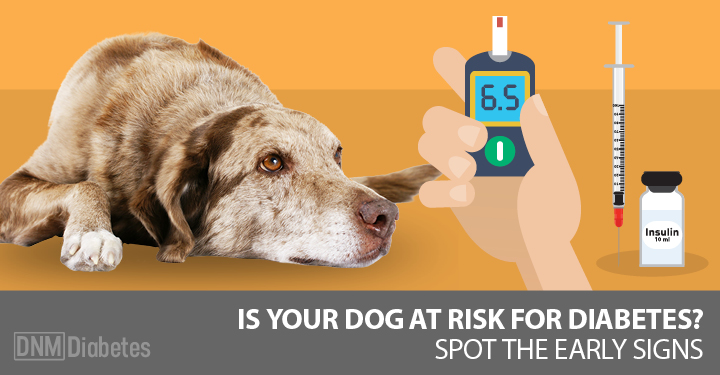Posted on 10 Oct 2017 in Disease, Darwin, Dogs
Diabetes in Dogs
Diabetes Mellitus in Dogs
What is diabetes?
During digestion, food is broken down into components that can be used by the body. Carbohydrates (starches) are converted into sugars. Glucose is the most important sugar. After absorption into the bloodstream, glucose provides the body’s cells with energy.
Want your dog checked out?
We offer diabetes testing for all Darwin dogs. Book an appointment today.
Glucose gets into cells through the actions of a hormone called insulin. If there is a shortage of insulin, glucose stays in the bloodstream and a condition known as diabetes mellitus develops.
Diabetes mellitus is basically a shortage of insulin. In some cases, this is a relative shortage brought about by overproduction of other hormones, which counteract the action of insulin.
Can your pet be cured of diabetes?
In general, diabetes mellitus in dogs is not curable but it is manageable. With your help and the care of your veterinary surgeon, your pet can lead a normal, healthy life. The keys to this are working with your veterinary surgeon and maintaining a regular diet and exercise routine, monitoring your dog’s signs and treatment with Caninsulin®.
Insulin
The hormone insulin that keeps your pet’s blood glucose normal is produced by special cells in the pancreas. In diabetic animals, these cells produce too little or no insulin.
Symptoms of diabetes
Excessive glucose in your pet’s blood can exceed the ‘glucose threshold’ of the kidneys. When this happens glucose is excreted in the urine. This results in extra fluid loss from the body causing the animal to drink and urinate more.
Glucose, an important fuel (energy source) is being lost. So, a diabetic animal may eat more than normal but lose weight.
The most important signs of diabetes mellitus in your pet are:
1. urinating too much
2. drinking too much water
3. increased appetite but losing weight
Diagnosis
Signs like those of diabetes mellitus may also be seen in other diseases. Your veterinary surgeon will confirm the diagnosis of diabetes in your pet by carrying out some examinations and tests, such as urine and blood tests.
Other hormones
The ovaries produce a hormone called progesterone during the part of the female dog’s cycle that follows ‘heat’. Progesterone has a negative influence on the action of insulin. Bitches with diabetes should be spayed as soon as possible to eliminate the progesterone source. Products containing progesterone-like substances, such as those used to suppress heat, should be avoided because they also counteract the action of insulin.

TREATMENT OF DIABETES
Insulin administration
Your pet’s insulin supply can be restored by regular injections of Caninsulin. This takes very little time and is not painful. Insulin is given twice a day, 12 hours apart.
Caninsulin treatment is tailored to suit each diabetic pet’s individual requirements. To begin with, your veterinary surgeon will establish a starting dose of Caninsulin for your pet based on its weight and possibly its blood glucose level.
Once stabilised on insulin, most diabetic dogs are able to lead a normal life. If we are having difficulty stabilising your dog, further testing for other underlying diseases may be required, or continuous glucose monitoring devices may be needed.
Monitoring at home
Monitoring your pet at home is critical to managing their diabetes. Your veterinary surgeon will use the information you provide, along with the data they collect, to design an effective treatment program for your pet. If your dog is drinking excessively, is lethargic, or is losing weight, it is important to talk to your vet because a change in insulin dose is likely to be required.
We would like you to monitor and record the following at home if possible:
1) Appetite, general demenour (eg. lethargic or bright) should be recorded each day
2) Insulin dose and amount/type of food fed should be recorded twice a day. Food should be carefully weighed, or a measuring cup used for each meal.
3) Water intake over a 24 hour period should be measured at least once a week. To do this measure the amount of water placed in your dog's bowl(s), and measure how much is left after 24 hours. If there is more than one pet drinking from the bowl it is still useful to measure the volume drunk by all the animals. If your dog drinks more than 60ml per kg of bodyweight in a 24 hour period please contact your vet.
4) Urine glucose and ketones should be measured at least once a week. Your vet will show you how to do this using urine strips. Dogs will often need a bit of gentle encouragement to become accustomed to you approaching them while urinating, but most dogs will readily accept urine collection. Record whether positive or negative for glucose and ketones (amount of glucose is not important, just whether present or not).
5) Body weight should ideally be recorded once a week.
Some people find it easiest to generate a spreadsheet to record this information, or you can just write it down each day.
Please bring this information to your revisit appointments with your vet.
Future adjustments
It is important to realise that diabetes is a constantly evolving disease. Although your diabetic pet may have been stable for a long time, changes in dose may suddenly be required. This is why it is important to continue to monitor your pet’s progress – even after months or years of treatment – and consult your veterinary surgeon if anything unusual occurs.
Once stabilised, if clinical signs at home are well controlled, a check up and a blood test called a Fructosamine test is usually recommended every 3 months. This test tells us information about glucose levels over the 2-3 weeks prior to the test. If signs are not well controlled, glucose curves will be needed to work out why.
Managing your pets diet and activity
The daily dose of Caninsulin is adjusted to match your pet’s daily energy requirements. So, your pet’s diet and activity are critical. Always try to feed your pet the same amount of the same food at the same time each day (usually 2 equal sized meals which are given at the same time as each insulin injection).
Your veterinary surgeon will advise on a commercial diet appropriate for your pet. Diets low in fat and with the right protein source are favoured for most diabetic pets. Don’t worry if your pet will not eat the special food. Although less ideal, a diabetic pet can be fed other types of food.
The activity level of your pet should remain unchanged and regular. If an animal is suddenly very active (e.g. longer walks, excitement about visitors, etc.) it uses more glucose (energy). This can result in very low blood sugar levels. In fact, very low glucose levels can deprive the brain of energy and your pet could lose consciousness. If this happens, you will need to administer glucose immediately (see “Be prepared for hypoglycaemia”).
To ensure a uniform diet, it is preferable to use commercial diets only. However tempting, never give your pet any titbits or treats unless these have been approved as suitable for a diabetic dog by your veterinary surgeon. This will require the co-operation of your family and friends too!

